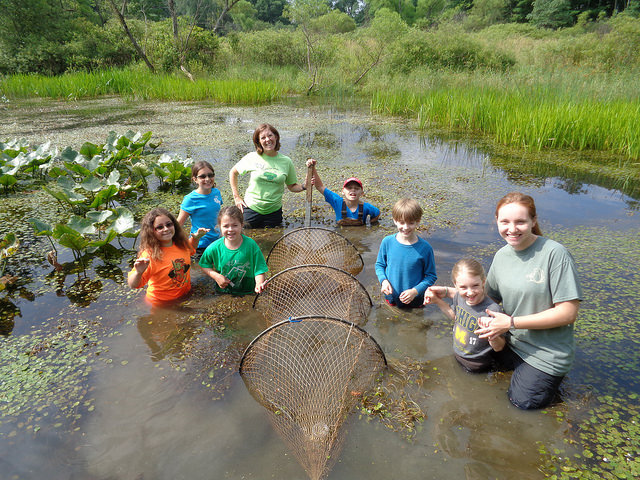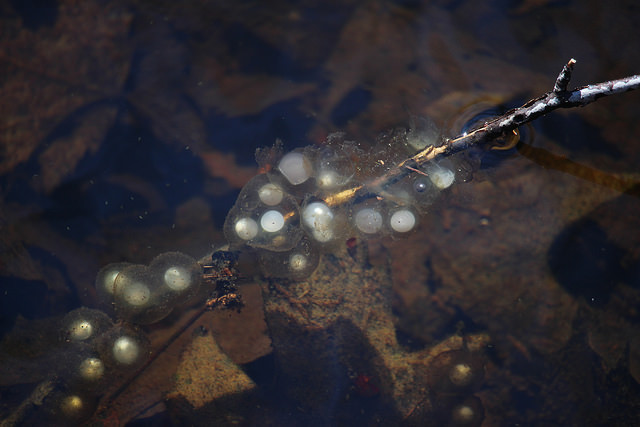Imagine two scenarios. It’s spring and a group of young kids are outside with an adult leader. They have had a lesson about animals that lay their eggs in water in the spring. They’ve learned about salamander, frog and toad eggs and are now out to see if they can find any evidence of those creatures.
In scenario one, a kid walks up to the pond and says “Are those eggs?” pointing to a whitish clump just under the water.
“No. That’s snow from yesterday’s winter weather” the leader responds.
The group walks on.
In scenario two, a kid walks up to the pond and says “Are those eggs?” pointing to a whitish clump just under the water.
“What do you think? Do you think they are eggs?” the leader asks as the rest of the group gathers around.
“They could be eggs” another kid says.
“How can you tell?” the leader asks.
“The eggs are clumpy and white” a kid chimes in. Others compare it to the eggs they’ve seen earlier.
“We can get them” someone else declares.
“How?” the leader asks.
“Go in the pond.”
“Who has the tallest boots on?”
After looking around at footwear, all the kids point to the leader. “You do!”
The leader goes in the pond, grabs the white clump and brings it out. The kids talk about how it feels, looks and falls apart as they poke and prod.
“It’s snow!” one kid proclaims. The others agree. The snow is placed on the ground and the group moves on.

Sometimes learning looks like this- wading through literal mud, or muddling through trying to make sense of our questions.
Both scenarios, while not captured verbatim, are completely real. I have witnessed variations on both. I have been a leader and a learner in both.
Each scenario has the same location, people and discovery. The difference? The leader answered the question with the truth in scenario one. In scenario two, the leader answered the question with another question. The questions eventually led to the truth but the journey was so much more interesting, thoughtful and empowering.
I’ve been thinking about questions lately as we gear up for spring and summer programs at Audubon. As a leader, a yes or no answer is simple. It is quick. It is sometimes necessary (Is the stove hot? Yes.) Yes or no may be all we have time for or all that we can provide at the moment.
I think about these situations being about the natural world, for that is what we teach about at Audubon. But in any situation when kids are exploring new objects, organisms and ideas questions naturally arise because they are naturally curious. When we answer the question we think we are making it easy but for whom? For the child or for ourselves?
When the learner gets the easy-to-give answer, they are let off the hook. They are done thinking about the question and often move on. They can hop from one to the next, grazing the surface, never sinking in. But when there is time to explore the question, it can be worth it.
When a question is answered with another question, the responsibility to learn is now back on the original asker. Ideas bounce back and forth like a ping-pong. And like a game, questioning takes skill and practice. And often patience. Sometimes learning is a struggle. And messy. But in the end discovering the answer for oneself is empowering. And it sets the learner up to want to discovery more. To learn more. And isn’t that what we want our children to do?

Children and adults can be curious about the same things, like salamander eggs.
Parents, teachers, grandparents, neighbors, aunts and uncles, friends. We can all be the leader. But even that word is misleading because it is often the child and their innate curiosity that does the leading. And as adults can we let it lead? Sometimes we have to pretend we don’t have the answer. But what if we get to a place where we really don’t? What if we have to say “I don’t know”? Great! The stage is set for authentic discovery as we play the role of co-investigator.
In my examples, the learners are children. But as adults we are still learners. Are we really that different in the way we learn and explore the world? Do we lose our sense of curiosity and wonder about the world as we age? Or do we find the world even more fascinating as we gain more experience in it? Our questions might be different than kids’ because they arise out of a more established framework of understanding of the world. Questions build upon themselves. One question leads to another.
Albert Einstein famously said “I have no special talent. I am only passionately curious.” Curiosity is a fire. When fanned with questions, rather than damped down with answers, who knows where it can go.
Audubon Community Nature Center builds and nurtures the connections between people and nature. The trails are open for hiking or skiing from dawn to dusk and the Nature Center is open from 10 a.m. – 4:30 p.m. daily except Sundays when it opens at 1 p.m. Visit auduboncnc.org for more information or call (716) 569-2345.
Katie Finch is a naturalist at ACNC.


Recent Comments